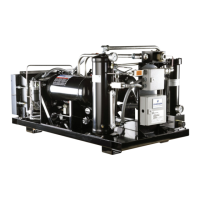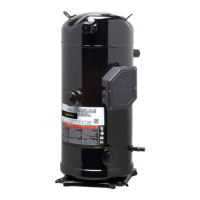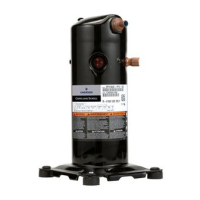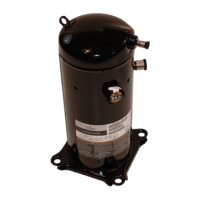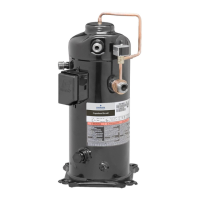14 C6.2.38/0719/E
3.7 Insulation material
Insulation material is typically used in a system to insulate the suction line, suction accumulator,
expansion valve bulb or discharge line thermostat. When choosing the insulation material, particular
attention shall be paid to its electrostatic charge, which could be a potential ignition source – see
EN 60079-0, clause 7.4.
3.8 Mufflers
External mufflers, normally applied to piston compressors in the past, may not be required for
Copeland Scroll compressors.
Individual system tests should be performed to verify acceptability of sound performance. If adequate
attenuation is not achieved, use a muffler with a larger cross-sectional area to inlet area ratio. A ratio
of 20:1 to 30:1 is recommended.
A hollow shell muffler will work quite well. Locate the muffler at minimum 15 to maximum 45 cm from
the compressor for the most effective operation. The further the muffler is placed from the
compressor within these ranges, the more effective. Choose a muffler with a length of 10 to
15 cm.
3.9 Reversing valve
A variable speed scroll brings a significant benefit during the defrost cycle. By taking advantage of
the higher speeds and flow rates, the defrost time will typically be shorter than in a fixed-speed
compressor system, which will reduce the time electric resistance heat is used during the defrost
cycle.
Reversing valve sizing must be within the guidelines of the valve manufacturer. Required pressure
drop to ensure valve shifting must be measured throughout the operating range of the unit and
compared to the valve manufacturer’s data. Conditions that generate low flow rates and low pressure
drop across the valve can result in a valve not shifting.
This can result in a condition where the compressor appears to be not pumping, ie, balanced
pressure. It can also produce elevated compressor sound levels. During a defrost cycle, when the
reversing valve abruptly changes the refrigerant flow direction, the suction and discharge pressures
will go outside of the operating envelope. The condition will usually cross the diagonal line
representing the lower right-hand side corner of the envelope. The sound that the compressor makes
during this transition period is normal, and the duration of the sound will depend on the coil volume,
outdoor ambient and system charge.
Since Copeland scroll compressors have a very high volumetric efficiency their displacements are
lower than those of equivalent capacity reciprocating compressors. As a result, Emerson
recommends that the capacity rating on reversing valves be no more than 1.5 to 2 times the nominal
capacity of the compressor in order to ensure proper operation of the reversing valve under all
operating conditions.
The reversing solenoid valve should be wired so that the valve does not reverse when the system is
shut off by the operating thermostat in the heating or cooling mode. If the valve is allowed to reverse
at system shut off, suction and discharge pressures are reversed to the compressor. This results in
a condition of system pressures equalizing through the compressor which can cause the compressor
to slowly rotate until the pressures equalize. This condition does not affect compressor durability but
can cause unexpected sound after the compressor is turned off.
The preferred method of mitigating defrost sound for the variable speed scroll is to signal the drive
to go to low speed when a defrost signal is received from the system. When low speed is reached,
the reversing valve is signalled to change positions. The system should be allowed to operate for 30
to 60 seconds at low speed for the suction and discharge pressures to stabilize. After 30 to 60
seconds the compressor speed should be increased to some predetermined speed based on the
outdoor ambient temperature. The routine at the end of the defrost cycle should be similar. The above
method is a suggestion and the system design engineer should develop the routine that best
mitigates compressor sound during defrost while ensuring a defrost cycle that is as short as possible.
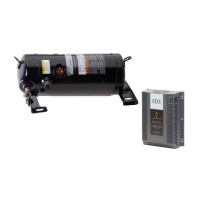
